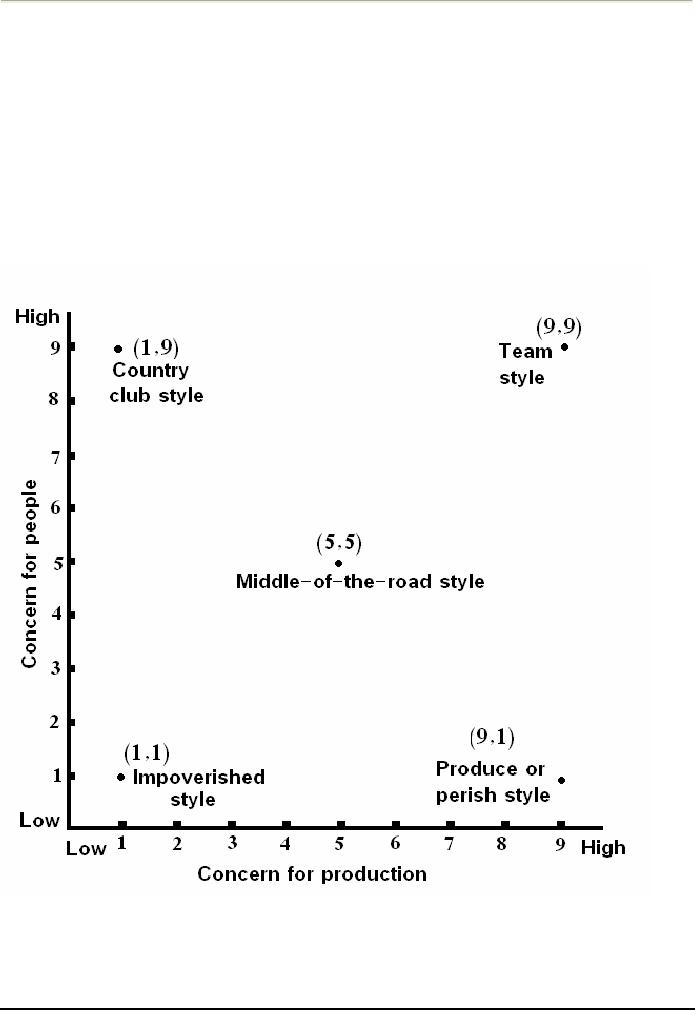 |

Organizational
Psychology (PSY510)
VU
LESSON
44
GREAT
LEADERS: STYLES, ACTIVITIES AND
SKILLS
The
IOWA Leadership Studies
A
series of pioneering leadership studies
conducted in the late 1930s by
Ronal Lippitt and Ralph K.
White
under
the general direction of Kurt
Lewin at the University of Iowa
have had a long lasting
impact. The
studies
found that:
1.
People react aggressive or
apathetically under authoritarian
leaders
2.
People react extremely
aggressively under laissez faire
leaders
3.
People's reaction of aggression falls
between those two extremes
in democratic leaders
The
Ohio State Leadership
Studies
These
studies were conducted in
1945 by the Bureau of Business
Research at Ohio State
University. These
researchers
saw to identify independent dimension of
leader behaviour. Beginning with
over thousand
dimensions,
they eventually narrowed the list in two
categories that substantially
accounted for most of
the
leadership
behaviour described by subordinates.
These called these two
dimensions, initiating structure
and
consideration.
Initiating
structure refers
to the extent to which a leader is likely
to define and structure his or
her role
and
those of subordinates in the search
for goal attainment. It includes
behaviour that attempts to
organize
work,
work relationships, and
goals. The leader
characterized as high in initiating
structure would be
described
in terms such as "assigns
group members to particular tasks,"
"expects workers to maintain
definite
standards of performance," and
"emphasizes the meetings of
deadlines."
Consideration
is
described as the extent to which a person
is likely to have job relationships
that are
characterized
by mutual trust, respect for subordinates
ideas, and regard for
their feelings. He or she
shows
concern
for followers comfort, well
being, status, and satisfaction. A
leader high in consideration as
one
who
helps subordinates with
personal problems, is friendly
and approachable, and treats
all subordinates as
equal.
Extensive
research based on these
definitions, found that
leaders high in initiating
structure and
considerations
tended to achieve high subordinate
performance and satisfaction
more frequently than
those
who
were rated low on either of the
two or both. However, the
high-high did not always
result in positive
consequences.
For example, leader
behaviour characterized as high on
initiating structure lead to
greater
rates
of grievances, absents, and
turnover and lower levels of
job satisfaction for the
workers performing
the
routine tasks. Other studies
found that high consideration
was negatively related to performance
ratings
of
the leader by his or her superior. In
conclusion, the Ohio state
studies suggested that the
high-high style
generally
resulted in positive outcomes,
but enough expectations were
found to indicate that situational
factors
needed to be integrated in to the
theory.
The
Michigan Leadership
Studies
These
studies were conducted around
1945 at the Survey Research
Centre at the University of
Michigan.
These
studies had the research objective to
locate behavioural characteristics of
leaders that appear to
be
related
to measures of performance
effectiveness.
The
Michigan group also came up
with two dimensions of
leadership behaviour that they labelled
employee
oriented
and production oriented. Employee-oriented
leaders were described as
emphasizing interpersonal
relations;
they took a personal interest in the
needs of the subordinates and
accepted individual
differences
among
members. The production-oriented
leaders, in contrast, tended to emphasize
the technical or task
aspects
of the job; their main
concern was in accomplishing
their group's task and the
group members were
a
means to that end.
The
conclusions arrived at by the Michigan
researchers strongly favoured the leaders
who were employee
oriented
in their behaviour. Employee-oriented
leaders were associated with
higher group productivity
and
higher
job satisfaction.
Production-oriented
leaders tended to be associated
with low group productivity
and lower job
satisfaction.
Globalization
and Leadership
Globalization
may simply be defined as the free
movement of:
o
Capital
o
Labour
o
Goods
and services
152

Organizational
Psychology (PSY510)
VU
across
various countries of the
world.
According
to the Wikipedia online encyclopedia,
Globalization refers to a process of
increasing global
connectivity
and integration between
nation-states, households/individuals corporations
and other
organizations.
It is an umbrella term referring to increased
interdependence in the economic,
social,
technological,
cultural, political, and ecological
spheres. Globalization also
has its impact on
leadership. It is
affecting
leadership in five
ways:
1.
Creating strategic
vision
Leaders
in the modern context need to have
strategic visions that fit
with the global village theme. As
the
world gets closer and
closer, competition due to
foreign firms is constantly on the rise.
Therefore,
in
order to survive, the leader
needs to develop a vision of global
competitiveness and global
expansion.
2.
Empowering employees
Global
leadership and management
can no more be a one man
show. Globalization has made
it
imperative
for leaders to empower
employees to make decisions
which are needed immediately. It
is
impossible
to keep pace with time if
such decisions are left to
the leader only.
3.
Acquiring and sharing
knowledge
As
the world moves towards a global village,
knowledge becomes the most important
and worthwhile
asset
of the companies. It has become
imperative for the leaders to develop
means and processes
to
acquire
and share knowledge from
outside the organization and within the
organization, in order for the
organization
to survive.
4.
Integrating knowledge
Acquiring
and sharing knowledge is the solution to
the global challenge. The
acquired knowledge needs
to
be integrated into the business processes
and made full use
of. Leaders have the responsibility
of
doing
so.
5.
Challenging status quo
Leaders
are also expected to
challenge the status quo in
face of globalization; organizations
which do no
adapt
to the changing environment and maintain
the status quo are expected
to be losers in the near
future.
Leadership
Styles
Leadership
style refers to the description of
leader's functioning. Several
researches have been
conducted on
how
leaders function in organizations,
and how managers and
leaders differ in their functions.
The Ohio
State
leadership studies came up
with two types of leadership
functions which were:
Initiating structure
and
Consideration.
Initiating structure refers to the extent
to which a leader is likely to
define and structure
his
or
her role and those of
subordinates in the search for
goal attainment. Consideration is described as
the
extent
to which a person is likely to
have job relationships that
are characterized by mutual trust,
respect for
subordinates
ideas, and regard for
their feelings. The Michigan
group also came up with
two dimensions of
leadership
behaviour that they labelled employee
oriented and production oriented.
Both these studies
labelled
the leaders as either somewhat, employee
oriented or task oriented. However,
four other researches
need
to quoted in this regard:
David
Nadler and Michael
Tushman
David
Nadler and Michael Tushman in
1990 came up with the
following functions of a charismatic
leader:
1.
Envisioning
An
envisioning leader is a one
who presents a prosperous
future to the followers; provides them hope
that
the future would be better than the
present and communicates
effectively the vision to the
followers.
2.
Energizing
He
energizes the members of the group
and is able to motivate them
towards the goal or the
vision.
3.
Enabling
He
helps the people psychologically and
physiologically in face of challenge,
giving them the courage
and
ability to get out of
difficult situations.
Robert
Tannenbaum and Warren
Schmidt
Robert
Tannenbaum and Warren Schmidt came up
with their explanation of leadership
styles as follows:
153

Organizational
Psychology (PSY510)
VU
1.
Boss-centred leadership
The
characteristics of a boss centred
leader are, he believes in
theory X, is autocratic, is
production
centred,
initiating structure, task
directed and directive. In other
words, he has little concern
for the
employees
and is more focused on the
task at hand.
2.
Employee-centred leadership
This
type of a leader is a proponent of theory
Y, is democratic, considerate, maintains
good human
relations,
supportive and participative. Therefore, the
employee centred leader has
a high concern for
his
employees.
Robert
Blake's and Jane Mouton's Managerial
Grid
The
Managerial Grid Model (1964) is a
behavioural leadership model developed by Robert Blake
and Jane
Mouton.
This model identifies five
different leadership styles
based on the concern for people
and the
concern
for production. The optimal
leadership style in this model is based
on Theory Y.
As
shown in the figure, the model is represented as a
grid with concern for
production as the X-axis
and
concern
for people as the Y-axis; each
axis ranges from 1 (Low) to
9 (High).
154

Organizational
Psychology (PSY510)
VU
The
five resulting leadership styles
are as follows:
The
impoverished style
(1,1)
In
this style, managers have
low concern for both people
and production. Managers use
this style to avoid
getting
into trouble. The main
concern for the manager is
not to be held responsible for
any mistakes,
which
results in less innovative
decisions.
Features
1. Does only enough to preserve
job and job seniority. 2.
Gives little and enjoys
little. 3. Protects
himself
by not being noticed by others.
Implications
1. Tries to stay in the same post
for a long time.
The
country club style (1,9)
This
style has a high concern
for people and a low concern
for production. Managers
using this style pay
much
attention to the security and
comfort of the employees, in hopes
that this would
increase
performance.
The resulting atmosphere is usually
friendly, but not
necessarily that
productive.
The
produce or perish style
(9,1)
With
a high concern for
production, and a low
concern for people, managers
using this style find
employee
needs
unimportant; they provide their
employees with money and
expect performance back.
Managers
using
this style also pressure
their employees through
rules and punishments to
achieve the company
goals.
This
dictatorial style is based on
Theory X of Douglas McGregor,
and is commonly applied by
companies
on
the edge of real or perceived
failure.This is used in case of crisis
management.
The
middle-of-the-road style (5,5)
Managers
using this style try to
balance between company
goals and workers' needs. By
giving some
concern
to both people and production,
managers who use this style
hope to achieve acceptable
performance.
The
team style (9,9)
In
this style, high concern is paid
both to people and production. As
suggested by the propositions of
Theory
Y, managers choosing to use this
style encourage teamwork and commitment
among employees.
This
method relies heavily on making employees
feel as a constructive part of the
company.
Paul
Hersey and Kenneth Blanchards
Paul
Hersey and Ken Blanchard
have developed a leadership model that
has gained a strong
following
among
management development specialists. This
model--called situational leadership
theory--has been
used
as a major training device at Fortune
500 companies. Situational leadership
uses the same two
leadership
dimensions that Fiedler identified:
task and relationship behaviours.
However, Hersey and
Blanchard
go a step further by considering
each as either high or low
and then combining them into
four
specific
behaviours:
1.
Telling style: (High
Task-Low Relationship) the leader defines
roles and tell people what,
how, when,
and
where to do various tasks. It
emphasizes directive behaviour.
2.
Selling style: (High
Task-High Relationship) the leader provides
both directive behaviour
and
supportive
behaviour.
3.
Participating style: (Low Task-High
Relationship) the leader and follower
share in decision making,
with
the
main role of the leader being
facilitating and
communicating.
4.
Delegating style: (Low Task-Low
Relationship) the leader provides little
direction or support.
REFERENCES
·
Luthans,
Fred. (2005). Organizational Behaviour (Tenth
Edition). United States:
McGraw Hill Irwin.
·
Mejia,
Gomez. Balkin, David &
Cardy, Rober. (2006). Managing Human
Resources (Fourth
Edition).
India:
Dorling Kidersley Pvt. Ltd.,
licensee of Pearson Education in South
Asia.
·
Robbins,
P., Stephen. (1996). Organizational
Behaviour (Seventh Edition). India:
Prentice Hall, Delhi.
·
Huczynski,
Andrzej & Buchanan, David.
(1991). Organizational Behaviour: An Introductory
Text
(Second
Edition). Prentice Hall. New
York.
·
Moorhead,
Gregory & Griffin, Ricky. (2001).
Organizational Behaviour (First Edition).
A.I.T.B.S.
Publishers
& Distributors. Delhi.
·
Robert
Blake
and
Jane
Mouton;
Managerial
Grid:
Retrieved
from:
http://en.wikipedia.org/wiki/Managerial_grid_model
·
Levitt,
Theodore. Globalization
of markets,
Harvard Business Review,
1983
155

Organizational
Psychology (PSY510)
VU
FURTHER
READING
·
Ohio
State Leadership
Studies:
http://changingminds.org/disciplines/leadership/actions/ohio_state.htm
·
Early
Years of the Ohio State
University Leadership
Studies:
http://jom.sagepub.com/cgi/content/abstract/5/2/127
·
Michigan
Leadership Studies:
http://changingminds.org/disciplines/leadership/actions/michigan.htm
-
·
Leadership
Studies:
http://www.ebsdublin.com/Subjects/Grad%20Dip/Leadership%20Studies%20-
%20Grad%20Dip.pdf
156
Table of Contents:
- INTRODUCTION TO ORGANIZATIONAL PSYCHLOGY:Hawthorne Effect
- METHODOLOGIES OF DATA COLLECTION:Observational method, Stability of Measures
- GLOBALIZATION:Aspects of Globalization, Industrial Globalization
- DEFINING THE CULTURE:Key Components of Culture, Individualism
- WHAT IS DIVERSITY?:Recruitment and Retention, Organizational approaches
- ETHICS:Sexual Harassment, Pay and Promotion Discrimination, Employee Privacy
- NATURE OF ORGANIZATIONS:Flat Organization, Neoclassical Organization Theory
- ORGANIZATIONAL CULTURE:Academy Culture, Baseball Team Culture, Fortress Culture
- CHANGING ORGANIZATIONAL CULTURE:Move decisively, defuse resistance
- REWARD SYSTEMS: PAY, Methods of Pay, Individual incentive plan, New Pay Techniques
- REWARD SYSTEMS: RECOGNITION AND BENEFITS, Efficiency Wage Theory
- PERCEPTION:How They Work Together, Gestalt Laws of Grouping, Closure
- PERCEPTUAL DEFENCE:Cognitive Dissonance Theory, Stereotyping
- ATTRIBUTION:Locus of Control, Fundamental Attribution Error
- IMPRESSION MANAGEMENT:Impression Construction, Self-focused IM
- PERSONALITY:Classifying Personality Theories, Humanistic/Existential
- PERSONALITY ASSESSMENT:Standardized, Basic Categories of Measures
- ATTITUDE:Emotional, Informational, Behavioural,Positive and Negative Affectivity
- JOB SATISFACTION:The work, Pay, Measurement of Job Satisfaction
- MOTIVATION:Extrinsic motive, Theories of work motivation, Safety needs
- THEORIES OF MOTIVATION:Instrumentality, Stacy Adams’S Equity theory
- MOTIVATION ACROSS CULTURES:Meaning of Work, Role of Religion
- POSITIVE PSYCHOLOGY:Criticisms of ‘Traditional’ Psychology, Optimism
- HOPE:Personality, Our goals, Satisfaction with important domains, Negative affect
- EMOTIONAL INTELLIGENCE:EI IS Related To Emotions and Intelligence
- SELF EFFICACY:Motivation, Perseverance, Thoughts, Sources of Self-Efficacy
- COMMUNICATION:Historical Background, Informal-Formal, Interpersonal Communication
- COMMUNICATION (Part II):Downward Communication, Stereotyping Problems
- DECISION MAKING:History, Personal Rationality, Social Model, Conceptual
- PARTICIPATIVE DECISION MAKING TECHNIQUES:Expertise, Thinking skills
- JOB STRESS:Distress and Eustress, Burnout, General Adaptation Syndrome
- INDIVIDUAL STRESSORS:Role Ambiguity/ Role Conflict, Personal Control
- EFFECTS OF STRESS:Physical Effects, Behavioural Effects, Individual Strategies
- POWER AND POLITICS:Coercive Power, Legitimate Power, Referent Power
- POLITICS:Sources of Politics in Organizations, Final Word about Power
- GROUPS AND TEAMS:Why Groups Are Formed, Forming, Storming
- DYSFUNCTIONS OF GROUPS:Norm Violation, Group Think, Risky Shift
- JOB DESIGN:Job Rotation, Job Enlargement, Job Enrichment, Skill Variety
- JOB DESIGN:Engagement, Disengagement, Social Information Processing, Motivation
- LEARNING:Motor Learning, Verbal Learning, Behaviouristic Theories, Acquisition
- OBMOD:Applications of OBMOD, Correcting Group Dysfunctions
- LEADERSHIP PROCESS:Managers versus Leaders, Defining Leadership
- MODERN THEORIES OF LEADERSHIP PROCESS:Transformational Leaders
- GREAT LEADERS: STYLES, ACTIVITIES AND SKILLS:Globalization and Leadership
- GREAT LEADERS: STYLES, ACTIVITIES AND SKILLS:Planning, Staffing